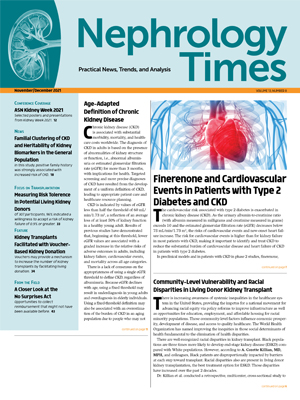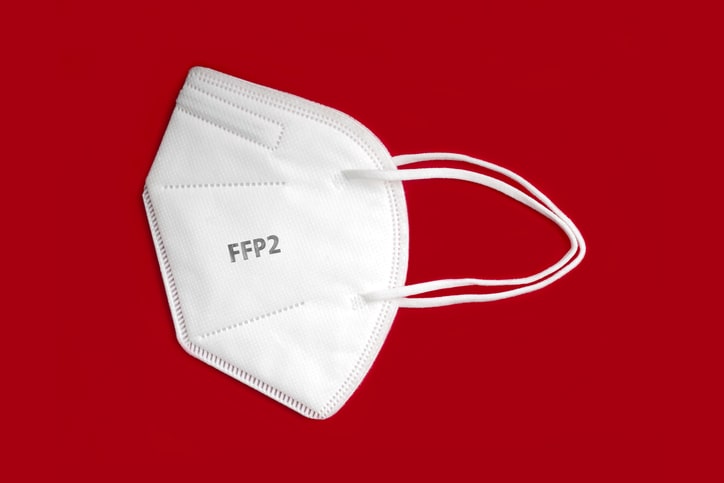
Worldwide, chronic kidney disease (CKD) affects approximately 697.5 million adults. Patients who progress from early stage CKD to kidney failure with replacement therapy (KFRT) are at increased risk for morbidity and mortality.
Activation of the innate and/or adaptive immune systems is central to the pathogenesis of many types of kidney disease. Results of the African American Study of Kidney Disease and Hypertension (AASK) demonstrated an association between higher baseline levels of soluble urokinase-type plasminogen activator receptor (suPAR), a biomarker of immune activation, and increased risk of progression of CKD and incident KFRT.
It is unclear whether other biomarkers of immune activation are associated with incident KFRT in African American patients with nondiabetic kidney disease. Teresa K. Chen, MD, MHS, and colleagues conducted a prospective cohort study to test the hypothesis that higher concentrations of specific biomarkers would be associated with greater risk of KFRT, progression of CKD, and all-cause mortality. The researchers further hypothesized that the biomarkers would augment risks associated with APOL1 for KFRT and CKD progression. Results of the study were reported in the American Journal of Kidney Diseases [2021;78(1):75-84].
The biomarkers of interest were soluble tumor necrosis factor (TNF) receptors 1 (sTNFR1) and 2 (sTNFR2), TNF-a, and interferon Y (IFN-y). The primary outcome of interest was incident KFRT. Secondary outcomes were all-cause mortality and CKD progression, defined as a doubling of serum creatinine or KFRT. Cox proportional hazards models were used to assess the association of each biomarker with KFRT.
Of the 1094 participants in the AASK trial, the 500 who had baseline serum samples available for measurement of biomarkers made up the study population for the current analysis. AASK participants without available samples had slightly higher mean measured glomerular filtration rate (mGFR) (46.4 vs 44.7 mL/min/1.733 m2) and suPAR levels (4487 vs 4417 pg/mL) than those with available samples; the two groups were similar in all other areas.
At baseline, mean age of the cohort was 54.1 years, 37% were female, mean mGFR was 44.7 mL/min/1.73 m2, and median urinary protein-creatinine ratio (UPCR) was 0.09 g/g. Median levels of biomarkers were: sTNFR1, 2875 pg/mL; sTNFR2, 13,021 pg/mL; TNF-a, 2.92 pg/mL; and IFN-y, 5.51 pg/mL. Those in the highest sTNFR1 tertile were significantly younger and had worse kidney functions compared with those in the lower tertiles. Participants in the higher tertiles of sTNFR1 also had higher median levels of other biomarkers of immune activation, including sTNFR2, TNF-a, and suPAR.
Of the 500 participants, 333 had available genotyping. Among participants with genotyping, 26% had APOL1 high-risk status and 74% had low-risk status. Participants in the APOL1 high-risk group were younger, had lower mean systolic blood pressure and mGFR, and had higher median UPCR, serum sTNFR1, sTNFR2, and suPAR than participants with low-risk status. At baseline, the two APOL1 risk groups were similar with respect to TNF-a and IFN- y.
Over a median follow-up of 8.5 years, 161 of the 500 participants developed KFRT. In unadjusted analyses, there was an association between each 2-fold higher baseline level of sTNFR1 and an 8.10-fold greater risk of incident KFRT (95% confidence interval [CI], 6.15-10.66). The association was robust to adjustment for demographic and clinical factors. On further adjustment for baseline mGFR and proteinuria, the association was attenuated but remained statistically significant (hazard ratio [HR], 3.66; 95% CI, 2.31-5.80). Each 2-fold higher baseline level of sTNFR2 was associated with a 2.29-fold increase in risk of incident KFRT in fully adjusted models.
The association between TNF-a with incident KFRT was smaller, but remained significant in both unadjusted and adjusted models (HR, 1.88, 95% CI, 1.54-2.29 and HR, 1.35, 95% CI, 1.07-1.71, respectively). There was no association between IFN-y levels and incident KFRT. In comparison, there was an association between each doubling of baseline suPAR concentration and a 1.39-fold greater risk of KFRT.
During a median follow-up of 9.6 years, there were 113 deaths. In unadjusted models, there were associations between each 2-fold higher baseline level of sTNFR1, sTNFR2, and TNF-a and a 1.7- to 1.8-fold greater risk of all-cause mortality. Following adjustment for demographic and clinical factors and baseline kidney function, the associations strengthened, with each 2-fold higher baseline level of those biomarkers associated with a 2.0- to 2.2-fold higher risk of death (all P≤.01). There was no association between baseline IFN-y and all-cause mortality.
Among the 333 participants with genotyping, following adjustment for APOL1 risk status and European ancestry, each 2-fold higher baseline level of sTNFR1 was associated with a significantly increased disk of KFRT (HR, 3.83; 95% CI, 2.21-6.61), CKD progression (HR, 2.76; 95% CI, 1.68-4.54), and mortality (HR, 2.88; 95% CI, 1.31-6.35). Trends were similar for sTNFR2 and TNF-a, but not for IFN-y.
The authors cited some limitations to the study findings, including the AASK trial participants being limited to African Americans with CKD attributed to hypertension, making the findings potentially ungeneralizable to other ethnic groups or CKD causes, and the small sample size, particularly for the analyses related to APOL1. The researchers also noted that although the results suggest a strong association between biomarkers and adverse outcomes, they do not imply causality.
In conclusion, the researchers said, “Among African Americans with CKD attributed to hypertension, baseline serum levels of sTNFR1, sTNFR2, and TNF-a were associated with adverse kidney outcomes and mortality, with sTNFR1 appearing to have the strongest associations. Future studies are needed to determine the clinical utility of measuring and/or targeting these biomarkers in both patient care and clinical trials.”
Takeaway Points
- Researchers conducted a prospective cohort study to test the hypothesis that higher concentrations of certain biomarkers in African Americans with chronic kidney disease (CKD) attributed to hypertension would be associated with greater risks of kidney failure with replacement therapy (KFRT), progression of CKD, and all-cause mortality.
- There were associations baseline levels of soluble tumor necrosis factor receptor 1 (sTNFR1), sTNFR2, and TNF-a and KFRT and mortality.
- There were no associations between interferon-y and KFRT or mortality.







 © 2025 Mashup Media, LLC, a Formedics Property. All Rights Reserved.
© 2025 Mashup Media, LLC, a Formedics Property. All Rights Reserved.